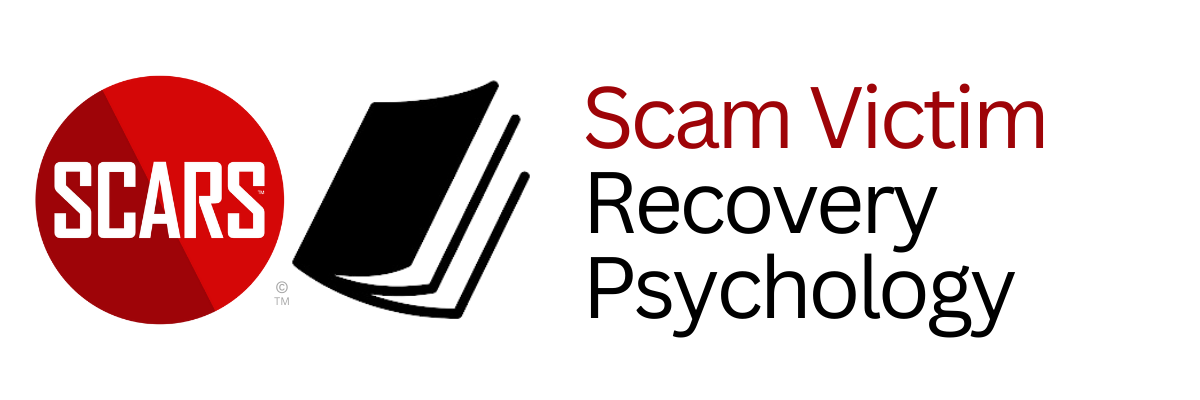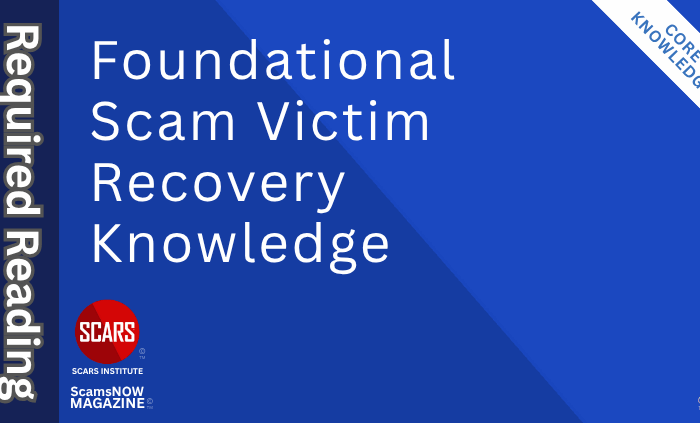
Distress Tolerance – How to Develop It
Distress Tolerance in Scam Victim Recovery is About Learning to Hold Pain Without Breaking
Primary Category: Scam Victim Recovery Psychology
Author:
• Vianey Gonzalez B.Sc(Psych) – Licensed Psychologist, Specialty in Crime Victim Trauma Therapy, Neuropsychologist, Certified Deception Professional, Psychology Advisory Panel & Director of the Society of Citizens Against Relationship Scams Inc.
• Tim McGuinness, Ph.D., DFin, MCPO, MAnth – Anthropologist, Scientist, Polymath, Director of the Society of Citizens Against Relationship Scams Inc.
Author Biographies Below
About This Article
Distress tolerance is the skill that allows you to endure emotional storms without collapsing or causing further harm. After betrayal trauma from a scam, your capacity to handle pain often feels shattered, leaving you overwhelmed by even small stressors. By learning to recognize your limits and practicing techniques such as grounding, radical acceptance, self-soothing, and pausing before reacting, you can gradually expand your ability to withstand distress. Each time you survive a painful moment without resorting to destructive choices, you strengthen your resilience and reclaim power. Building distress tolerance does not erase betrayal, but it gives you the inner stability to survive grief, shame, and anger while moving forward toward healing and a meaningful future.
Note: This article is intended for informational purposes and does not replace professional medical advice. If you are experiencing distress, please consult a qualified mental health professional.

Distress Tolerance in Scam Victim Recovery: Learning to Hold Pain Without Breaking
Distress tolerance is about when you have lived through betrayal trauma after being scammed, the pain does not arrive gently, but you can learn how to better tolerate it so it can be processed more completely.
Emotion and pain flood your mind and body. You may feel waves of anger, shame, grief, or fear that threaten to drown you. In those moments, you may tell yourself that you cannot stand it, that the intensity is too much, and that you will collapse under the weight. Yet there is a psychological skill that can change how you survive these storms. It is called distress tolerance.
Distress tolerance does not mean you stop feeling pain. It does not mean the memories suddenly stop hurting. Instead, it is your ability to hold pain without breaking, to face emotional storms without running, and to remain steady enough to survive the moment without destroying yourself or your future. Distress tolerance is not a luxury; it is a survival skill that becomes essential in recovery.
In betrayal trauma, this skill is often damaged or underdeveloped. The scammer pulled you into cycles of manipulation, reward, and punishment, leaving you raw and vulnerable. After the scam ends, you are left facing emotions that feel unbearable. Building distress tolerance is not about ignoring those emotions. It is about learning to live with them long enough to move through them safely and to prevent them from pushing you into decisions or actions that create more harm.
What Distress Tolerance Is
Distress tolerance is the capacity to handle intense emotional states without panicking or resorting to destructive behaviors. It means you can sit with anger without exploding, feel shame without hiding, or grieve without collapsing into despair. It is the difference between saying “I cannot stand this pain” and “This pain is hard, but I can survive it.”
At its core, distress tolerance is a resilience skill. It recognizes that pain cannot always be fixed instantly, nor can it be avoided forever. You cannot erase betrayal, and you cannot rush grief. What you can do is strengthen your ability to endure, moment by moment, until emotions soften enough for you to think clearly and make wise choices.
Think of distress tolerance as building a container inside you. When pain comes, the container holds it without spilling over. Without this skill, every surge of emotion floods your life, pulling you into panic, withdrawal, or harmful choices. With it, you learn that feelings rise, peak, and eventually fall. You learn that you can outlast them.
Why Distress Tolerance Matters for Scam Victims
Trauma Weakens Emotional Capacity
Betrayal trauma overwhelms the nervous system. When the scam ended, your body and mind may have gone into survival mode. Stress hormones stayed high, sleep broke apart, and ordinary coping skills failed. In this fragile state, even small frustrations may feel unbearable. A delayed message, a bill in the mail, or a careless comment from someone close can spark outsized reactions because your capacity to tolerate distress has been drained.
Recognizing this is not weakness. It is the natural consequence of trauma. The scammer used manipulation to stretch your emotional system to its breaking point. Now your distress tolerance must be rebuilt piece by piece.
Suppression Creates Pressure
Many scam victims try to push pain away. You may tell yourself “I should be over this by now” or “If I ignore it, it will fade.” Yet what you suppress does not vanish. It grows in silence and leaks out in moments of stress. Avoidance shrinks your tolerance over time because you never practice sitting with distress. Each time you refuse to face pain, the next wave feels even harder.
Developing distress tolerance means turning toward discomfort instead of away from it. It means training yourself to breathe through intensity, trust that it will pass, and remind yourself that survival is possible.
Impulsive Reactions Create More Harm
Low distress tolerance often leads to quick, desperate attempts to escape pain. This can mean lashing out at others, making reckless financial decisions, falling into unhealthy relationships, or seeking temporary relief through alcohol, drugs, or compulsive behaviors. These reactions may numb for a moment, but they bring consequences that deepen suffering.
Growing distress tolerance allows you to pause between feeling and reacting. That pause is where wisdom and choice live. It is where you can say, “I feel like I cannot take this, but I will not make it worse.” That single pause can protect your recovery.
Recognizing Your Level of Distress Tolerance
Signs of Low Distress Tolerance
You may notice low distress tolerance if you often:
-
- Say or think, “I cannot handle this” when facing strong emotions.
- Feel overwhelmed by ordinary stressors like daily tasks or conversations.
- Rush to escape emotions through distractions, avoidance, or impulsive choices.
- React strongly in ways that you later regret, such as yelling, withdrawing, or overspending.
- Experience physical symptoms like racing heart, shallow breath, or trembling during emotional moments.
These signs do not mean you are broken. They mean your emotional container is too small and needs strengthening.
Signs of Growing Distress Tolerance
You may notice stronger distress tolerance when you:
-
- Pause before reacting, even for a few seconds.
- Remind yourself that feelings, no matter how strong, eventually pass.
- Use coping strategies to ride out emotional storms without causing new damage.
- Accept that discomfort is part of healing rather than seeing it as proof of failure.
- Begin to trust that you can survive difficult moments without falling apart.
Tracking these changes helps you see progress. Even small improvements matter because they show your container is growing.
How to Develop Distress Tolerance
Building Awareness
You cannot strengthen what you cannot see. The first step is to notice your reactions to distress. Pay attention to the physical signs of escalation: shallow breathing, muscle tension, or racing thoughts. Notice the phrases that arise in your mind, such as “I cannot take this anymore” or “This will never end.” Awareness gives you the chance to intervene before intensity takes control.
Try keeping a journal of distress episodes. Write down what triggered them, what you felt in your body, what thoughts appeared, and how you responded. Over time, you will see patterns that guide your growth.
Practicing Radical Acceptance
Distress tolerance grows when you stop fighting reality. Radical acceptance means acknowledging, “This is happening. I do not like it, but it is real.” When you resist reality, you double your pain. You suffer from the event itself and from the belief that it should not exist. Acceptance reduces the second layer of suffering and frees energy to survive the moment.
For scam victims, this may sound like “I was deceived. It hurts deeply, and I will not pretend otherwise. I cannot change the past, but I can choose how I respond now.” That acceptance does not mean approval; it means refusing to waste energy on denial.
Using Grounding Techniques
Grounding techniques calm the body and anchor you in the present. They help your nervous system remember that the distress of the moment is not the same as danger. You might:
-
- Breathe slowly and count each inhale and exhale up to ten.
- Place your feet on the floor and describe five things you see in the room.
- Hold an object and focus on its texture, weight, and temperature.
- Run cold water over your hands to shift physical focus.
These techniques buy you time. They remind you that emotions are temporary waves, not permanent truths.
Developing Self-Soothing Skills
Self-soothing means offering yourself comfort when emotions surge. You might play calming music, wrap yourself in a blanket, sip warm tea, or take a gentle walk. You might light a candle and focus on the flame, or repeat a phrase such as “I am safe now.”
These small acts matter. They signal to your nervous system that you are cared for, even when no one else is present. Self-soothing is not indulgence. It is survival practice.
Practicing the Pause
The most powerful tool of distress tolerance is the pause. In the pause, you hold back from reacting, even for a moment, and allow the wave to crest and fall. During the pause, you breathe, ground, and remind yourself, “I can stand this pain. I do not have to act on it.”
The pause can be a few seconds or a few minutes. Over time, the pause grows longer. It becomes the space where wisdom enters and choices improve.
Building Meaning and Purpose
Distress tolerance becomes easier when you know why you are enduring pain. Recovery is not only about surviving but also about building a meaningful life. Ask yourself: “What values do I want to live by? What kind of person do I want to become?” When you connect pain to purpose, endurance feels less like punishment and more like an investment.
You might remind yourself, “I am enduring this storm because I want to rebuild trust in myself,” or “I am tolerating this pain because I want to show my children resilience.” Purpose gives strength when emotions test your limits.
Growing Distress Tolerance Over Time
Distress tolerance is not built in a single effort. It is a gradual process that strengthens with practice. Each time you survive distress without destroying yourself, you prove to your nervous system that you can endure. That memory makes the next wave less threatening.
Think of it like building muscle. At first, even light weights feel heavy. Over time, repetition creates strength. The same is true with emotions. Each practice session, each pause, each acceptance, each moment of self-soothing, adds to your resilience.
You will not always succeed. Sometimes emotions will overwhelm you, and you may fall back into old habits. That does not erase progress. Growth comes from returning to practice, forgiving yourself, and continuing the work. Over months, you will notice more control, more patience, and more trust in yourself.
Conclusion
Distress tolerance is your ability to hold pain without breaking. After betrayal trauma, this skill is often weakened, leaving you vulnerable to overwhelm and impulsive reactions. Low distress tolerance shows itself in panic, avoidance, or destructive choices. High distress tolerance shows itself in pauses, acceptance, and survival without harm.
You develop distress tolerance through awareness, radical acceptance, grounding, self-soothing, pausing, and building purpose. Each practice session strengthens your inner container, allowing you to hold more emotion safely. You learn that pain rises and falls, and that you can outlast it.
This skill does not remove betrayal trauma, but it changes your relationship to it. Instead of running from distress or collapsing under it, you learn to endure, survive, and grow. Each time you face distress without breaking, you reclaim power that the scam once stole. You remind yourself that you are stronger than the storm, and that even the fiercest emotions cannot define or destroy you.
Glossary
- Acceptance — Acceptance means facing reality as it is, without fighting or denying it. In recovery, this looks like saying “This happened to me, and it hurts” rather than pretending it didn’t or wishing it away. Acceptance does not mean approval; it means saving energy by no longer resisting what is already true.
- Affect Regulation — Affect regulation is your ability to manage the intensity of emotions so they stay within a tolerable range. When you regulate affect, you prevent overwhelming feelings from taking full control. This skill grows as you learn to calm your nervous system and regain balance during emotional storms.
- Awareness — Awareness is noticing what is happening in your body, mind, and emotions during distress. It is the first step in distress tolerance because you cannot change what you cannot see. Journaling, mindfulness, and checking in with your physical sensations all strengthen awareness.
- Betrayal Trauma — Betrayal trauma occurs when someone you trusted deceives or manipulates you, such as in a scam. The shock is deeper than ordinary loss because it attacks both your safety and your ability to trust. This form of trauma leaves you with confusion, self-blame, and strong emotional wounds.
- Coping Strategies — Coping strategies are methods you use to manage difficult emotions or situations. Some strategies are healthy, like grounding or self-soothing, while others may be harmful, like substance use or reckless spending. Learning new, healthier coping tools expands your distress tolerance.
- Crisis Survival Skills — These are short-term tools that help you endure intense distress without making it worse. They are not designed to solve the problem permanently but to get you through the storm safely. Skills like grounding, pausing, and urge surfing belong in this category.
- Distress — Distress is the feeling of intense emotional or physical discomfort that feels unbearable in the moment. Scam victims often describe distress as waves of grief, shame, or anger that arrive suddenly. Recognizing distress as temporary makes it easier to manage.
- Distress Intolerance — Distress intolerance is the sense that you cannot stand painful emotions even for a short time. When this happens, you may turn to impulsive or self-destructive behaviors to escape. Learning distress tolerance skills gradually reduces this feeling.
- Distress Tolerance — Distress tolerance is the ability to survive painful emotions without panicking or making the situation worse. It means holding emotional storms with enough stability to let them pass. Building this skill is essential in scam recovery because betrayal brings strong emotions you cannot erase immediately.
- Emotional Container — This is the inner strength you use to hold overwhelming feelings without collapsing. When your container is too small, distress spills over into destructive behavior. As you grow tolerance, you expand this container so it can hold pain safely.
- Emotional Flooding — Emotional flooding happens when a surge of feelings overwhelms your thinking mind. You may freeze, lash out, or shut down. Flooding is a sign that your container needs strengthening, and grounding practices can help reduce its intensity.
- Emotional Numbing — Numbing is when you avoid feelings by shutting them down or distracting yourself. It may provide short relief but lowers your ability to face distress in the long term. Scam victims often numb through overwork, endless scrolling, or withdrawal from people.
- Grounding Techniques — Grounding anchors you in the present moment when emotions feel too strong. Simple actions like naming five things you see, focusing on your breath, or holding a cool object remind your nervous system that you are safe now. These skills give your mind and body a pause from distress.
- Impulsive Reactions — Impulsive reactions are quick, unplanned responses to overwhelming emotions. They often provide short relief but create new problems, like lashing out at loved ones or making reckless choices. Distress tolerance gives you tools to pause before acting.
- Journaling — Journaling is writing down your thoughts, feelings, and body reactions. This practice increases awareness and helps you see patterns in how you respond to distress. For many scam victims, journaling becomes a safe outlet for pain that feels unspeakable.
- Mindfulness — Mindfulness is paying attention to the present without judgment. It helps you notice emotions as they rise and fall, instead of being consumed by them. Regular mindfulness practice expands your ability to tolerate distress.
- Pausing — Pausing means deliberately waiting before reacting to strong feelings. Even a few seconds of pause can prevent harmful choices and give you time to breathe or ground yourself. Over time, pausing becomes a powerful habit that protects your recovery.
- Radical Acceptance — Radical acceptance means fully acknowledging reality, even when it is painful. For scam victims, this may sound like “I was deceived, and it hurts, but denying it will not help me heal.” This approach reduces secondary suffering created by resistance.
- Recovery Skills — Recovery skills are emotional tools you practice to rebuild stability after trauma. Distress tolerance is one of the most important of these. Each new skill you develop makes the healing process steadier.
- Resilience — Resilience is your capacity to adapt and recover after pain. It grows each time you face distress and survive without destroying yourself. Scam recovery strengthens resilience by teaching you that even betrayal cannot erase your ability to move forward.
- Safe Space — A safe space is an environment where you can express emotions without fear of harm or judgment. Therapy sessions, support groups, or private rituals can serve as safe spaces. Having them ensures that when distress surfaces, you have somewhere it can be released safely.
- Self-Compassion — Self-compassion means treating yourself kindly when you are in pain. Instead of harsh self-criticism, you respond with understanding, patience, and care. It helps reduce shame, which often intensifies distress.
- Self-Soothing — Self-soothing is the practice of comforting yourself in healthy ways when emotions rise. Warm tea, calming music, gentle walks, or a soft blanket can all signal safety to your nervous system. These practices calm your body while you endure distress.
- Somatic Awareness — Somatic awareness is noticing how your body carries distress. You may feel it as tight muscles, shallow breathing, or stomach knots. Learning these signals helps you respond early before distress becomes overwhelming.
- Suppression — Suppression is the act of pushing down emotions or memories you do not want to face. It may feel protective, but over time it weakens distress tolerance and allows hidden pain to grow stronger. Healing requires moving from suppression to safe expression.
- Tolerance Growth — Tolerance growth is the process of gradually expanding your capacity to endure distress. Like building muscle, it happens through practice and repetition. Each success in surviving distress without harm strengthens your ability for the next time.
- Triggers — Triggers are cues that remind you of the scam or betrayal. They may be words, images, places, or even body sensations. Recognizing triggers helps you prepare coping strategies instead of being blindsided.
- Urge Surfing — Urge surfing is observing strong impulses without acting on them. You ride the wave of desire or fear until it passes, reminding yourself that urges are temporary. This skill prevents destructive actions in moments of distress.
- Validation — Validation is recognizing that your feelings are real and understandable. It does not mean agreement, only acknowledgment. Telling yourself “Of course I feel hurt; anyone betrayed this way would” is an example of self-validation.
Author Biographies
-/ 30 /-
What do you think about this?
Please share your thoughts in a comment below!
TABLE OF CONTENTS
- Distress Tolerance in Scam Victim Recovery is About Learning to Hold Pain Without Breaking
- Distress Tolerance in Scam Victim Recovery: Learning to Hold Pain Without Breaking
- What Distress Tolerance Is
- Why Distress Tolerance Matters for Scam Victims
- Recognizing Your Level of Distress Tolerance
- How to Develop Distress Tolerance
- Growing Distress Tolerance Over Time
- Conclusion
- Glossary
CATEGORIES
![NavyLogo@4x-81[1] Distress Tolerance - How to Develop It - 2025](https://scamsnow.com/wp-content/uploads/2025/04/NavyLogo@4x-811.png)
ARTICLE META
Important Information for New Scam Victims
- Please visit www.ScamVictimsSupport.org – a SCARS Website for New Scam Victims & Sextortion Victims.
- SCARS Institute now offers its free, safe, and private Scam Survivor’s Support Community at www.SCARScommunity.org – this is not on a social media platform, it is our own safe & secure platform created by the SCARS Institute especially for scam victims & survivors.
- SCARS Institute now offers a free recovery learning program at www.SCARSeducation.org.
- Please visit www.ScamPsychology.org – to more fully understand the psychological concepts involved in scams and scam victim recovery.
If you are looking for local trauma counselors, please visit counseling.AgainstScams.org
If you need to speak with someone now, you can dial 988 or find phone numbers for crisis hotlines all around the world here: www.opencounseling.com/suicide-hotlines
Statement About Victim Blaming
Some of our articles discuss various aspects of victims. This is both about better understanding victims (the science of victimology) and their behaviors and psychology. This helps us to educate victims/survivors about why these crimes happened and not to blame themselves, better develop recovery programs, and help victims avoid scams in the future. At times, this may sound like blaming the victim, but it does not blame scam victims; we are simply explaining the hows and whys of the experience victims have.
These articles, about the Psychology of Scams or Victim Psychology – meaning that all humans have psychological or cognitive characteristics in common that can either be exploited or work against us – help us all to understand the unique challenges victims face before, during, and after scams, fraud, or cybercrimes. These sometimes talk about some of the vulnerabilities the scammers exploit. Victims rarely have control of them or are even aware of them, until something like a scam happens, and then they can learn how their mind works and how to overcome these mechanisms.
Articles like these help victims and others understand these processes and how to help prevent them from being exploited again or to help them recover more easily by understanding their post-scam behaviors. Learn more about the Psychology of Scams at www.ScamPsychology.org
SCARS INSTITUTE RESOURCES:
If You Have Been Victimized By A Scam Or Cybercrime
♦ If you are a victim of scams, go to www.ScamVictimsSupport.org for real knowledge and help
♦ SCARS Institute now offers its free, safe, and private Scam Survivor’s Support Community at www.SCARScommunity.org/register – this is not on a social media platform, it is our own safe & secure platform created by the SCARS Institute especially for scam victims & survivors.
♦ Enroll in SCARS Scam Survivor’s School now at www.SCARSeducation.org
♦ To report criminals, visit https://reporting.AgainstScams.org – we will NEVER give your data to money recovery companies like some do!
♦ Follow us and find our podcasts, webinars, and helpful videos on YouTube: https://www.youtube.com/@RomancescamsNowcom
♦ Learn about the Psychology of Scams at www.ScamPsychology.org
♦ Dig deeper into the reality of scams, fraud, and cybercrime at www.ScamsNOW.com and www.RomanceScamsNOW.com
♦ Scam Survivor’s Stories: www.ScamSurvivorStories.org
♦ For Scam Victim Advocates visit www.ScamVictimsAdvocates.org
♦ See more scammer photos on www.ScammerPhotos.com
You can also find the SCARS Institute’s knowledge and information on Facebook, Instagram, X, LinkedIn, and TruthSocial
Psychology Disclaimer:
All articles about psychology and the human brain on this website are for information & education only
The information provided in this and other SCARS articles are intended for educational and self-help purposes only and should not be construed as a substitute for professional therapy or counseling.
Note about Mindfulness: Mindfulness practices have the potential to create psychological distress for some individuals. Please consult a mental health professional or experienced meditation instructor for guidance should you encounter difficulties.
While any self-help techniques outlined herein may be beneficial for scam victims seeking to recover from their experience and move towards recovery, it is important to consult with a qualified mental health professional before initiating any course of action. Each individual’s experience and needs are unique, and what works for one person may not be suitable for another.
Additionally, any approach may not be appropriate for individuals with certain pre-existing mental health conditions or trauma histories. It is advisable to seek guidance from a licensed therapist or counselor who can provide personalized support, guidance, and treatment tailored to your specific needs.
If you are experiencing significant distress or emotional difficulties related to a scam or other traumatic event, please consult your doctor or mental health provider for appropriate care and support.
Also read our SCARS Institute Statement about Professional Care for Scam Victims – click here
If you are in crisis, feeling desperate, or in despair, please call 988 or your local crisis hotline – international numbers here.
More ScamsNOW.com Articles
A Question of Trust
At the SCARS Institute, we invite you to do your own research on the topics we speak about and publish. Our team investigates the subject being discussed, especially when it comes to understanding the scam victims-survivors’ experience. You can do Google searches, but in many cases, you will have to wade through scientific papers and studies. However, remember that biases and perspectives matter and influence the outcome. Regardless, we encourage you to explore these topics as thoroughly as you can for your own awareness.
























![scars-institute[1] Distress Tolerance - How to Develop It - 2025](https://scamsnow.com/wp-content/uploads/2025/04/scars-institute1.png)
![niprc1.png1_-150×1501-1[1] Distress Tolerance - How to Develop It - 2025](https://scamsnow.com/wp-content/uploads/2025/04/niprc1.png1_-150x1501-11.webp)
